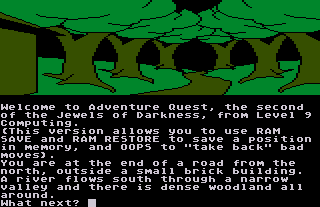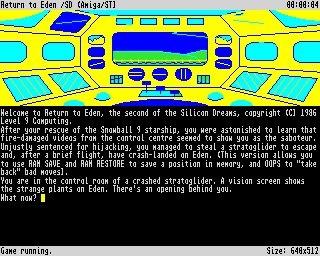Level 9, like Infocom, developed their games with VM technology, and likewise made their games available on an enormous variety of computer platforms without truly 'porting' them. Unlike Infocom, though, they worked with commercially available microcomputers, not mainframes like the PDP-10, and the concept of a "lead platform' makes more sense, especially considering that Level 9 adopted graphics much more early on than Infocom, which had to be designed with a particular platform's video abilities in mind.
Unknown lead platform:
Snowball
Released for Atari 8-bit, BBC Micro, Camputers Lynx, Commodore 64, Nascom, Oric, and ZX Spectrum in 1983.
Released for Amstrad CPC, Memotech MTX, and MSX in 1984.
Lords of Time
Released for Atari 8-bit and MSX in 1983
Released for BBC Micro, Commodore 64, Nascom, Oric, and ZX Spectrum in January 1984
Released for Memotech MTX in September 1984
Released for Amstrad CPC in 1984
Austin didn't mention anything about Atari or MSX development, so it is a little strange, and incongruous with other titles, that these platforms have the earliest release dates for this game. It's possible that the lead platform was Nascom or BBC Micro but they were simply delayed. It's also possible that Mobygames is wrong.
Return to Eden
Released for Commodore 64 in October 1984
Released for Amstrad CPC in November 1984
Released for Enterprise in 1985
This was Level 9's first graphical game, and to my eyes the Commodore 64's look appears to be the "correct" one, though the MSX and ZX Spectrum versions are clearly derivative of the Amstrad CPC. Austin's notes don't help confirm this theory, though, as he recalls switching to the Atari ST for the graphical games, but Return to Eden predates the platform and was never released on it individually.
Releases for the Atari, BBC, Memotech, and Nascom are non-graphical.
| C64 (VICE) | C64 (Level9.Net) |
 |
 |
| CPC (Caprice) | MSX (OpenMSX) |
 |
 |
| ZX Spectrum (Fuse) | ZX Spectrum (Level9.Net) |
 |
 |
The Worm in Paradise
Released for Commodore 64 and BBC Micro in December 1985
Released for MSX in 1985
Released for Amstrad CPC in January 1986
Released for ZX Spectrum in December 1986
Released for Atari 8-bit in 1986
The Commodore 64 and Amstrad CPC use somewhat different graphics. MSX is derived from the C64 set, and the Spectrum's graphics are derived from the later Amstrad set. Atari and BBC are non-graphical.
| C64 | |
 |
|
| Amstrad CPC | ZX Spectrum |
 |
 |
Jewels of Darkness
Released for Amiga, Amstrad CPC, Amstrad PCW, Apple II, Atari 8-bit, Atari ST, Commodore 64, DOS, Macintosh, MSX, and ZX Spectrum in 1986.
This is a compilation of graphical remakes of Colossal Adventure, Adventure Quest, and Dungeon Adventure. There are three distinct graphic version categories.
- "16-bit," used by Amiga, Atari ST, and DOS
- "8-bit," used by Amstrad CPC, Amstrad PCW, Atari 8-bit, C64, and MSX
- ZX Spectrum uses its own graphics set
I could not find any Apple II versions of this game.
To my eyes, the Atari ST version appears to be the most "correct" of the 16-bit versions, which is consistent with Austin's account that they eventually switched to the Atari ST for lead development, though he did not specify when. Amiga looks similar but with different, more garish colors. Unfortunately when I emulate this version, the text display is illegible, and I have yet to figure out why.
The 8-bit versions look similar to the 16-bit versions but with reduced detail, and of them, the Atari graphics once again look the most pleasing to me.
ZX Spectrum is reduced even further in detail.
| Atari ST | Amiga |
 |
 |
| PC | Amiga/PC (Level9.Net) |
 |
 |
| Atari 8-bit (Altirra) | Atari 8-bit (Level9.Net) |
 |
 |
| Commodore 64 | Amstrad CPC |
 |
 |
| Amstrad PCW | |
 |
|
| ZX Spectrum (Fuse) | ZX Spectrum (Level9.Net) |
 |
 |
Silicon Dreams
Released for Amiga, Amstrad CPC, Amstrad PCW, Apple II, Atari 8-bit, Atari ST, Commodore 64, Macintosh, MSX, and ZX Spectrum in 1986.
Released for DOS in 1987.
Like Jewels of Darkness, Silicon Dreams is a compilation of graphical remakes, this time of Snowball, Return to Eden, and The Worm in Paradise. The situation here is much more complicated than in JoD.
With Snowball, which was originally a non-graphical game, there are two distinct graphical versions in SD. Unlike JoD, they differ rather significantly.
- "16-bit," used by Amiga, Atari ST, Amstrad CPC, Amstrad PCW, and DOS
- "8-bit," used by Apple II, Atari 8-bit, Commodore 64, and ZX Spectrum
| Atari ST | Amiga |
 |
 |
| Amiga/ST (Level9.Net) | |
 |
|
| PC | Amstrad CPC |
 |
| Atari 8-bit (Altirra) | Atari 8-bit (Level9.Net) |
| ZX Spectrum (Fuse) | ZX Spectrum (Level9.Net) |
 |
|
| Commodore 64 | Apple II |
 |
Return to Eden's old graphics are remade, also in two distinct graphical versions.
- "16-bit," used by Amiga, Atari ST, Amstrad CPC, and Amstrad PCW
- "8-bit," used Apple II, Atari 8-bit, DOS, and ZX Spectrum
| Atari ST | Amiga |
 |
 |
| Amiga/ST (Level9.Net) | Amstrad CPC |
 |
| Atari 8-bit (Altirra) | Atari 8-bit (Level9.Net) |
| PC (DOSBox) | PC (Level9.Net) |
 |
 |
| ZX Spectrum (Fuse) | ZX Spectrum (Level9.Net) |
| Apple II | |
 |
Commodore 64 does not use the 8-bit remake set, but instead uses the graphics from the old Amstrad version. I have no idea why.
But the strangest is The Worm in Paradise, where the graphics are not remade, but instead the graphics from the old versions are reused, seemingly at total random.
- "1985," used by Amiga, Atari ST, Amstrad CPC, Amstrad PCW, and MSX
- "1986," used by Apple II, Atari 8-bit, Commodore 64, DOS, and ZX Spectrum
| Atari ST | Amiga |
 |
 |
| Amstrad CPC | MSX |
| Atari 8-bit | Commodore 64 |
| PC | Apple II |
 |
 |
| ZX Spectrum (Fuse) | ZX Spectrum (Level9.Net) |
The 1985 set, first used in the standalone C64 release, is now used by Amstrad CPC, while the 1986 set, first used in the standalone Amstrad CPC release, is now used by C64! Maybe if you only played on one of these platforms, the swap would trick you into thinking it was something new? On the other hand, the MSX and ZX Spectrum versions' graphics aren't changed.
About the only points of consistency between Jewels of Darkness and Silicon Dreams is that Amiga and Atari ST look like each other, but Atari 8-bit doesn't. The other 8-bit machines are usually aligned with Atari 8-bit, but not always.
- Amstrad's computers are aligned with the graphics of the 8-bit machines for Jewels of Darkness but aligned with the 16-bit for Silicon Dreams.
- Apple II is aligned with the 8-bit machines for Silicon Dreams but I can't find any copies of Jewels of Darkness.
- Commodore 64 is mostly aligned with the 8-bit machines, but for Return to Eden uses the old Amstrad graphics instead of the new 8-bit graphics.
- DOS is all over the place, aligning with 16-bit for Jewels of Darkness and Snowball, but with 8-bit for Return to Eden and The Worm in Paradise.
- Macintosh is a total mystery, as I couldn't find any playable copies for it.
- MSX aligns with 16-bit Jewels of Darkness and The Worm in Paradise, but I could not find copies of SD versions of Snowball and Return to Eden.
- ZX Spectrum is aligned with the 8-bit machines, though in the case of Jewels of Darkness it has been manually reduced in detail whereas in Silicon Dreams it lets the interpreter do the work.
Time and Magik: The Trilogy
Released for Amiga, Amstrad CPC, Amstrad PCW, Atari 8-bit, Atari ST, BBC Micro, Commodore 64, DOS, Macintosh, MSX, and ZX Spectrum in 1988.
The earlier Level 9 games Knight Orc and Gnome Ranger use 32 colors, but only on Amiga, so I can declare them Amiga games with some confidence. Atari ST and DOS use a reduced 16 color palette, Macintosh is monochrome, and the others either use an alternate 8-bit graphics set which seems to have been designed for the Commodore 64, or are non-graphical.
But the rest of Level 9's subsequent adventures are 16 colors on Amiga, and in the case of Time and Magik, is nearly indistinguishable from the Atari ST version, which looks just a touch brighter if compared very closely. So here I am uncertain that Amiga remained the lead platform. The DOS version, though 16 colors as well, uses a different EGA palette and looks generally worse than the Amiga/ST versions.
Lancelot
Released for Amiga, Amstrad CPC, Amstrad PCW, Atari 8-bit, Atari ST, BBC Micro, Commodore 64, DOS, MSX, and ZX Spectrum in 1988.
Ported to Macintosh in February 1989.
Scapeghost
Released for Amiga, Amstrad CPC, Amstrad PCW, Atari 8-bit, Atari ST, BBC Micro, Commodore 64, DOS, and ZX Spectrum in 1989.
Select chronology:
Mike Austin stated that they started with the Nascom 1.
| Title | Year | Contemporary ports |
| Asteroids | 1982 |
|
| Adventure Quest |
1982 | Same-year port to BBC Micro 1983 ports to various microcomputers |
| Colossal Adventure |
1982 |
Same-year port to BBC Micro 1983 ports to various microcomputers |
| Dungeon Adventure |
1982 | Same-year port to BBC Micro 1983 ports to various microcomputers |
| Title | Lead platform | Year | Contemporary ports |
| Snowball | ??? | 1983 | Too many to fit here |
| Lords of Time |
??? | 1983 | Same-year releases on Atari 8-bit & MSX 1984 releases on various microcomputers |
| Title | Lead platform | Date | Contemporary ports |
| Return to Eden |
??? | 1984-10 | Same-quarter releases on Commodore 64 and Amstrad CPC Same-year releases on various microcomputers 1985 port to Enterprise |
| The Worm in Paradise |
??? | 1985-12 | Same-year releases on Commodore 64, BBC Micro, and MSX January 1986 release on Amstrad CPC 1986 releases on Atari 8-bit and ZX Spectrum |
| Title | Lead platform | Year |
| Jewels of Darkness |
??? | 1986 |
| Silicon Dreams |
??? | 1986 |
| Title | Lead Platform | Year |
| Knight Orc |
Amiga | 1987-8 |
| Gnome Ranger |
Amiga | 1987 |
| Time and Magik: The Trilogy |
??? | 1988 |
| Lancelot | ??? | 1988 |
| Scapeghost | ??? | 1989 |










